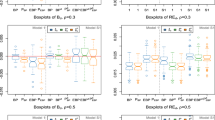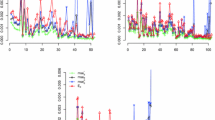Abstract
For estimating area-specific parameters such as poverty indicators in a finite population, estimators based only on the area-specific samples have typically high variability due to small sample sizes, and model-based methods are recognized to be useful to increase the accuracy of the estimation by borrowing information from related areas. This article proposes an Bayesian approach to this problem based on random effects models. To address the non-normality of response variables and possible spatial correlations among geographically neighboring areas, we introduce random effects models with a parametric family of transformations and spatially correlated random area effects. We assign prior distributions on unknown parameters including transformation and spatial correlation parameters and provide an efficient posterior computation algorithm for estimation and inference for area-specific population parameters via Markov Chain Monte Carlo. We demonstrate the performance of the proposed methods together with existing methods through simulation and empirical studies.





Similar content being viewed by others
References
Banerjee, S., Carlin, B. P., & Gelfand, A. E. (2014). Hierarchical modeling and analysis for spatial data (2nd ed.). Boca Raton: Chapman & Hall.
Battese, G., Harter, R., & Fuller, W. (1988). An error-components model for prediction of county crop areas using survey and satellite data. Journal of the American Statistical Association, 83, 28–36.
Chambers, R., Chandra, H., Salvati, N., & Tzavidis, N. (2014). Outliner robust small area estimation. Journal of the Royal Statistical Society Series B, 76, 47–69.
Foster, J., Greer, J., & Thorbecke, E. (1984). A class of decomposable poverty measures. Econometrica, 52, 761–766.
Hall, P., & Maiti, T. (2006). On parametric bootstrap methods for small area prediction. Journal of the Royal Statistical Society Series B, 68, 221–238.
Jiang, J., & Lahiri, P. (2006). Estimation of finite population domain means: A model-assisted empirical best prediction approach. Journal of the American Statistical Association, 101, 301–311.
Lahiri, P., & Mukherjee, K. (2007). On the design consistency property of hierarchical bayes estimators in finite population sampling. The Annals of Statistics, 35, 724–737.
Molina, I., & Marhuenda, Y. (2015). SAE: An R package for small area estimation. The R Journal, 7, 81–98.
Molina, I., & Martin, N. (2018). Empirical best prediction under a nested error model with log transformation. The Annals of Statistics, 46, 1961–1993.
Molina, I., Nandram, B., & Rao, J. N. K. (2014). Small area estimation of general parameters with application to poverty indicators: A hierarchical bayes approach. The Annals of Applied Statistics, 8, 852–885.
Molina, I., & Rao, J. N. K. (2010). Small area estimation of poverty indicators. Canadian Journal of Statistics, 38, 369–385.
Pratesi, M., & Salvati, N. (2008). Small area estimation: The eblup estimator based on spatially correlated random area effects. Statistical Methods and Applications, 17, 113–141.
Pratesi, M., & Salvati, N. (2009). Small area estimation in the presence of correlated random area effects. Journal of Official Statistics, 25, 37–53.
Rao, J. N. K., & Molina, I. (2015). Small Area Estimation (2nd ed.). New York: Wiley.
Schmid, T., Tzavidis, N., Münnich, R., & Chambers, R. (2016). Outlier robust small-area estimation under spatial correlation. Scandinavian Journal of Statistics, 43, 806–826.
Slud, E., & Maiti, T. (2006). Mean-squared error estimation in transformed fay-herriot models. Journal of the Royal Statistical Society Series B, 68, 239–257.
Sugasawa, S., & Kubokawa, T. (2017). Transforming response values in small area prediction. Computational Statistics and Data Analysis, 114, 47–60.
Sugasawa, S., & Kubokawa, T. (2019). Adaptively transformed mixed model prediction of general finite population parameters. Scandinavian Journal of Statistics, 46, 1025–1046.
Yang, Z. L. (2006). A modified family of power transformations. Economics Letters, 92, 14–19.
Acknowledgements
This research was supported by Grant-in-Aid for Japanese Society for Promotion of Science (KAKENHI) Grant numbers 18K12757.
Author information
Authors and Affiliations
Corresponding author
Ethics declarations
Conflict of interest
The author declares no conflicts of interest.
Additional information
Publisher's Note
Springer Nature remains neutral with regard to jurisdictional claims in published maps and institutional affiliations.
Rights and permissions
About this article
Cite this article
Sugasawa, S. Small area estimation of general parameters: Bayesian transformed spatial prediction approach. Jpn J Stat Data Sci 3, 167–181 (2020). https://doi.org/10.1007/s42081-019-00067-7
Received:
Accepted:
Published:
Issue Date:
DOI: https://doi.org/10.1007/s42081-019-00067-7




